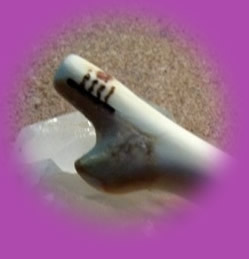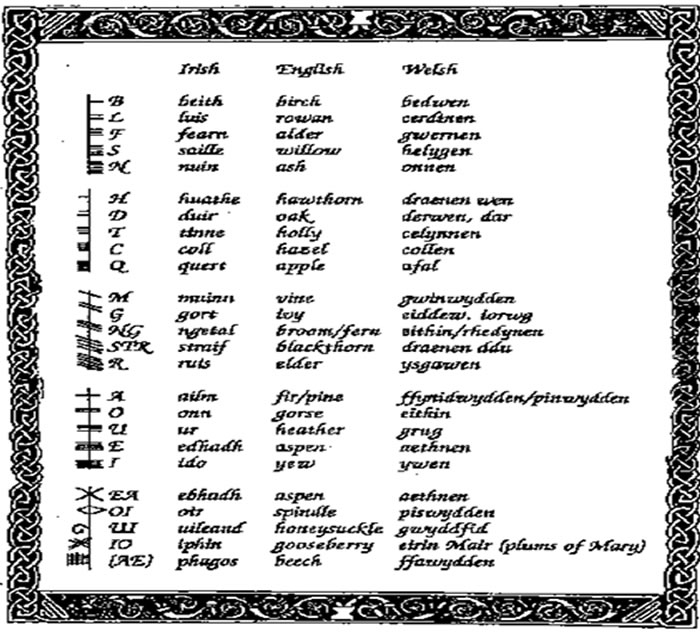Ogham & Celtic
On the natural wood hairsticks I will burn the Ogham name for the wood onto the end of the stick. This page is about the origins of the ancient Ogham script and names.
Current understanding is that the names of the main twenty letters of Ogham are also the names of 20 trees sacred to the druids and is often referred to as the "Celtic Tree Alphabet", based on a High Medieval Bríatharogam ("wood ogham") tradition ascribing names of trees to the individual letters. There are roughly 400 surviving Ogham inscriptions on stone monuments throughout Ireland and western Britain, the bulk of them are in the south of Ireland, in Counties Kerry, Cork and Waterford. The largest number outside of Ireland is in Pembrokeshire in Wales. The remainder are mostly in south-eastern Ireland, Scotland, the Isle of Man, and England around the Devon/Cornwall border. The vast majority of the inscriptions consist of personal names.
sacred to the druids and is often referred to as the "Celtic Tree Alphabet", based on a High Medieval Bríatharogam ("wood ogham") tradition ascribing names of trees to the individual letters. There are roughly 400 surviving Ogham inscriptions on stone monuments throughout Ireland and western Britain, the bulk of them are in the south of Ireland, in Counties Kerry, Cork and Waterford. The largest number outside of Ireland is in Pembrokeshire in Wales. The remainder are mostly in south-eastern Ireland, Scotland, the Isle of Man, and England around the Devon/Cornwall border. The vast majority of the inscriptions consist of personal names.
The earliest inscriptions in Ogham dates to about the 4th century AD, but some believe its invention could possibly be as early as the 1st century BC. The use of "classical" Ogham in stone inscriptions was very popular in the 5th–6th centuries, it is however clear that the alphabet predates the 5th century. A period of writing on wood or other perishable material prior to the preserved monumental inscriptions needs to be assumed.
Ogham was carved and read from bottom to top and on occasion from right to left.
It is suggested that Ogham was first created as a cryptic alphabet, designed by the Irish. It is believed by some that the alphabet was created by Irish scholars or druids for political, military or religious reasons to provide a secret means of communication in opposition to the authorities of The Roman Britain Empire, which then ruled over neighbouring southern Britain, represented a very real threat of invasion to Ireland, which may have acted as a spur to the creation of the alphabet.

 Represents the drawing of the three powers of maiden, mother and crone. It is a sign of female power and especially power through transition and growth. Three is a number of mystical significance among the Celts, and the trinity of these figures held enormous magic. Usually depicted holding symbols from harvest or hunt, the Triple Mother in her more tame state would serve as a figure of good harvest, and good health. Also symbolic of the stages of life, each feminine figure represents crone, mother, and maiden – a culmination of the three would signify the power of unity.
Represents the drawing of the three powers of maiden, mother and crone. It is a sign of female power and especially power through transition and growth. Three is a number of mystical significance among the Celts, and the trinity of these figures held enormous magic. Usually depicted holding symbols from harvest or hunt, the Triple Mother in her more tame state would serve as a figure of good harvest, and good health. Also symbolic of the stages of life, each feminine figure represents crone, mother, and maiden – a culmination of the three would signify the power of unity.
Single Spiral:
Double Spiral:
Triquetra:
Three Rays (Arwen):
Current understanding is that the names of the main twenty letters of Ogham are also the names of 20 trees
 sacred to the druids and is often referred to as the "Celtic Tree Alphabet", based on a High Medieval Bríatharogam ("wood ogham") tradition ascribing names of trees to the individual letters. There are roughly 400 surviving Ogham inscriptions on stone monuments throughout Ireland and western Britain, the bulk of them are in the south of Ireland, in Counties Kerry, Cork and Waterford. The largest number outside of Ireland is in Pembrokeshire in Wales. The remainder are mostly in south-eastern Ireland, Scotland, the Isle of Man, and England around the Devon/Cornwall border. The vast majority of the inscriptions consist of personal names.
sacred to the druids and is often referred to as the "Celtic Tree Alphabet", based on a High Medieval Bríatharogam ("wood ogham") tradition ascribing names of trees to the individual letters. There are roughly 400 surviving Ogham inscriptions on stone monuments throughout Ireland and western Britain, the bulk of them are in the south of Ireland, in Counties Kerry, Cork and Waterford. The largest number outside of Ireland is in Pembrokeshire in Wales. The remainder are mostly in south-eastern Ireland, Scotland, the Isle of Man, and England around the Devon/Cornwall border. The vast majority of the inscriptions consist of personal names.
The earliest inscriptions in Ogham dates to about the 4th century AD, but some believe its invention could possibly be as early as the 1st century BC. The use of "classical" Ogham in stone inscriptions was very popular in the 5th–6th centuries, it is however clear that the alphabet predates the 5th century. A period of writing on wood or other perishable material prior to the preserved monumental inscriptions needs to be assumed.
Ogham was carved and read from bottom to top and on occasion from right to left.
It is suggested that Ogham was first created as a cryptic alphabet, designed by the Irish. It is believed by some that the alphabet was created by Irish scholars or druids for political, military or religious reasons to provide a secret means of communication in opposition to the authorities of The Roman Britain Empire, which then ruled over neighbouring southern Britain, represented a very real threat of invasion to Ireland, which may have acted as a spur to the creation of the alphabet.

Celtic & Druidic Symbols
Triple Spiral: Represents the drawing of the three powers of maiden, mother and crone. It is a sign of female power and especially power through transition and growth. Three is a number of mystical significance among the Celts, and the trinity of these figures held enormous magic. Usually depicted holding symbols from harvest or hunt, the Triple Mother in her more tame state would serve as a figure of good harvest, and good health. Also symbolic of the stages of life, each feminine figure represents crone, mother, and maiden – a culmination of the three would signify the power of unity.
Represents the drawing of the three powers of maiden, mother and crone. It is a sign of female power and especially power through transition and growth. Three is a number of mystical significance among the Celts, and the trinity of these figures held enormous magic. Usually depicted holding symbols from harvest or hunt, the Triple Mother in her more tame state would serve as a figure of good harvest, and good health. Also symbolic of the stages of life, each feminine figure represents crone, mother, and maiden – a culmination of the three would signify the power of unity.
Single Spiral:

Represents ethereal energy radiating out (or inward depending on your perspective) Also symbolizes growth, birth and expansion of consciousness.
Double Spiral:

A sign of balance and also representative of the equinoxes.
Triquetra:

Latin meaning "three-cornered". Often seen as a holy symbol but it has many meanings. It varies in its aspects of spirit, nature, being-ness, and of the cosmos
Three Rays (Arwen):

The first and third rays in this symbol represent male and female energy . The middle ray represents the balance of both energies.

